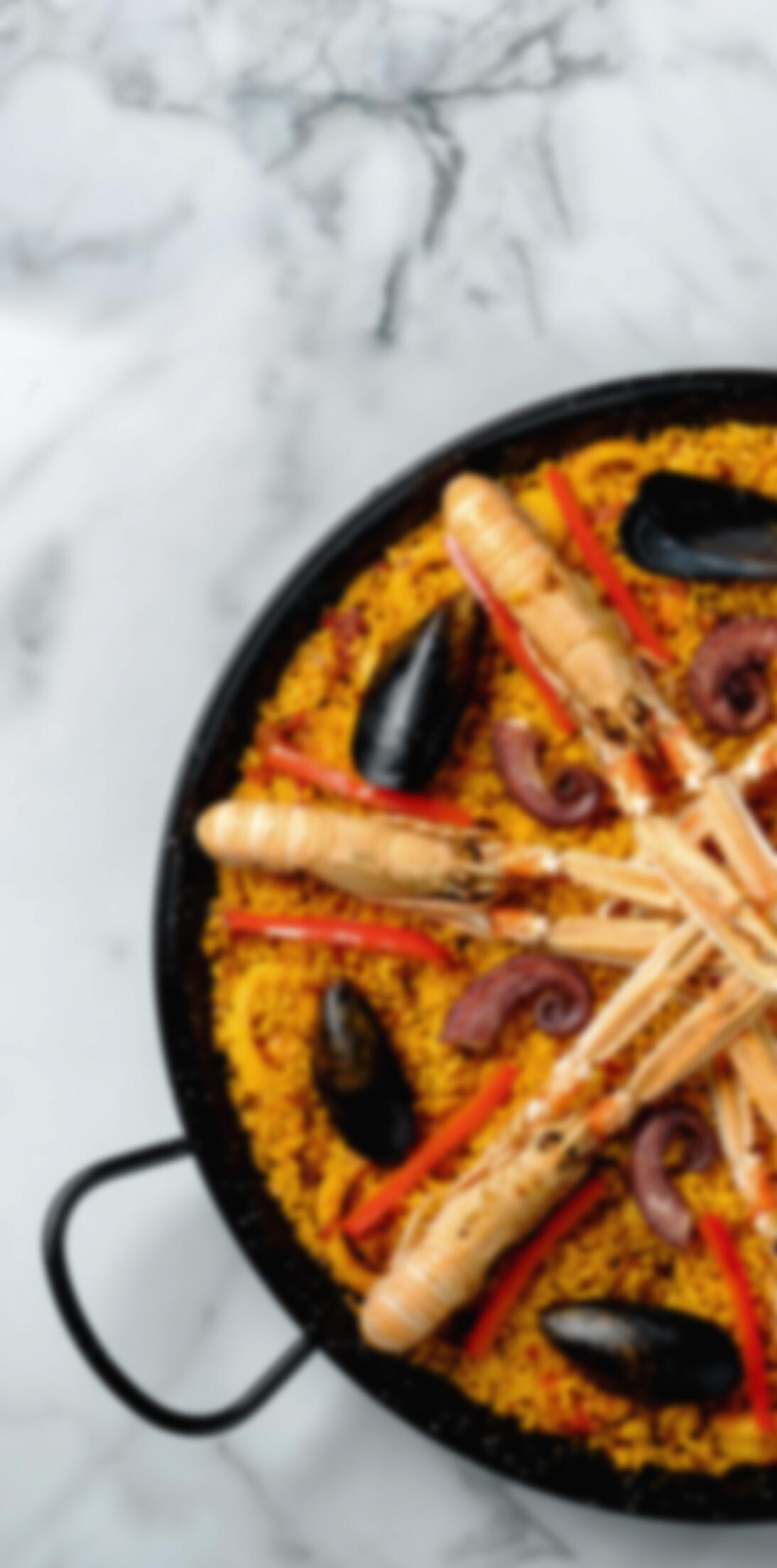




WeareveryproudtoannounceourveryfirsteBook,AllAboutPaella. As your one-stop source for all gourmet cooking needs, we are passionate about sharing everything we know about this iconic dish inSpanishgastronomywithallourcustomers
Paella is a traditional Spanish dish that is enjoyed worldwide. It is a one-pan meal that is packed with flavor and loaded with fresh ingredients. Our eBook will cover everything you need to know about making paella, from the history of the dish to the ingredients, equipmentandthecookingprocess
In addition, we will provide a guide on choosing the right equipment for your needs and how to set-up and maintain your paella pans. We will also provide recommendations for wines and other beverages to pair with your paella, as well as suggestions for side dishes and dessertstocompleteyourSpanishfeast
At TerraMar Imports, we are committed to providing our customers with the highest quality ingredients and tools for their gourmet cooking needs. Our eBook, All About Paella, is an extension of our commitment to excellence, and we hope it will inspire you to explore therichanddiverseculinarytraditionsofSpain.
So, whether you are an experienced chef or a beginner, our eBook is for you. We invite you to join us on this culinary adventure and discovertheartofmakingpaellalikeapro!






We are excited to take you on a delectable journey through the rich history, flavors, and traditions of one of the most iconic dishes from Spain: Paella.

Born in the heart of the Valencian region on the eastern coast of Spain, paella is a dish that truly captures the essence of its birthplace Dating back to the mid-19th century, paella has evolved over time, blending together diverse ingredients, influences, and techniques that have come to symbolize Spanish cuisine Today, it is not just a dish; it is a symbol of conviviality and togetherness, as friends and families gather around a large pan to share this mouthwatering meal.
The origin of paella can be traced to humble beginnings. The Moors, who occupied Spain for centuries, introduced rice to the region, and soon it became a staple ingredient for the locals Farmers and laborers in the Valencian countryside would cook their lunch over an open fire, combining rice with whatever ingredients they could find – be it vegetables, meats, or seafood The word "paella" itself comes from the Old French word "paelle," which means "pan," and it's no surprise that the dish takes its name from the large, shallow pan in which it is traditionally cooked.
In this eBook, we will guide you through the fascinating story of paella, exploring its origins, its journey across Spain and beyond, and the traditional techniques that have been passed down through generations We will also share with you some of our favorite paella recipes, tips for selecting the best ingredients, and secrets for achieving the perfect balance of flavors. So grab your paella pan, gather your loved ones, and let's embark on a culinary adventure that will tantalize your taste buds and bring the vibrant spirit of Spain to your table!
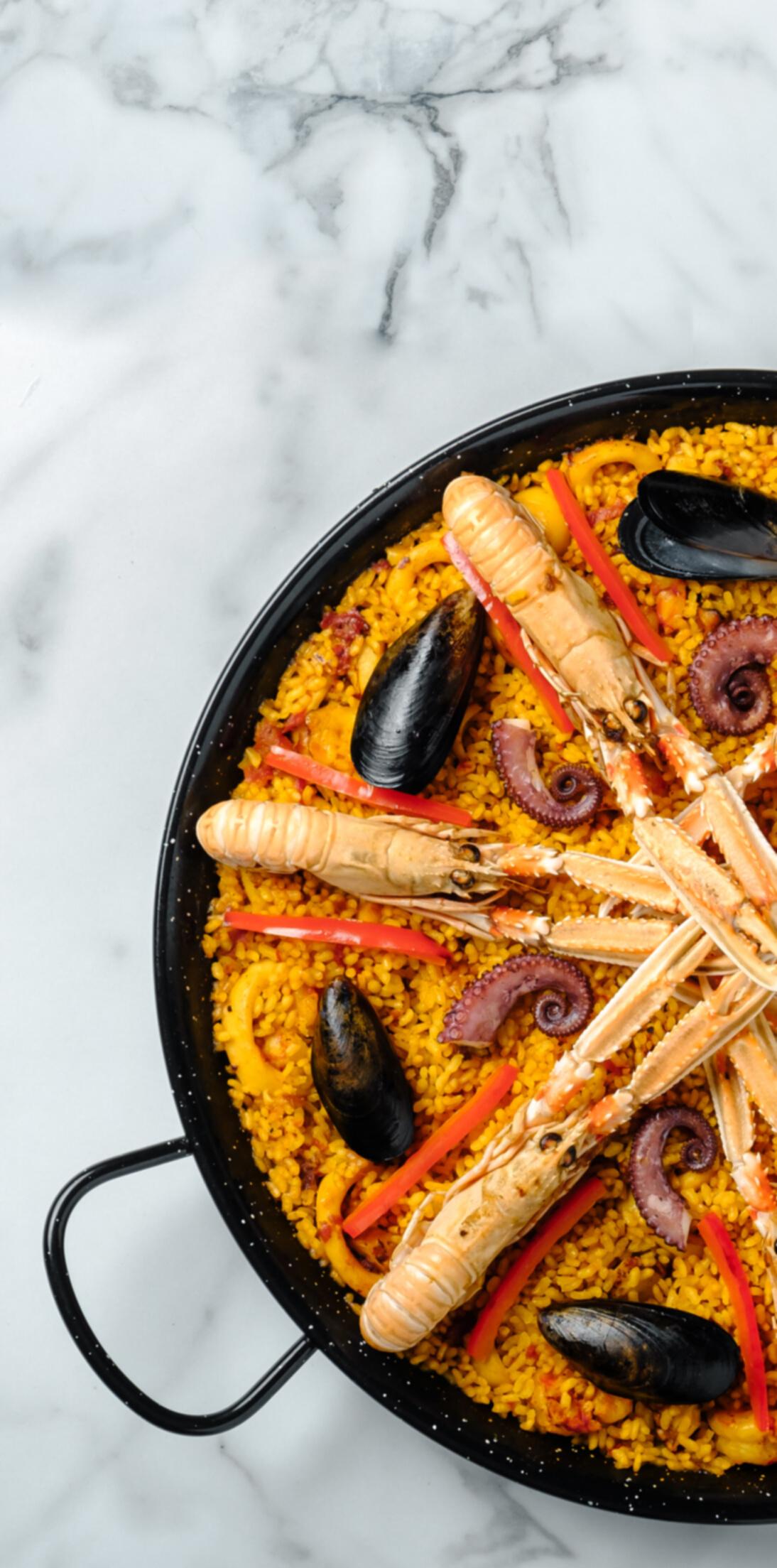



Welcome to the essential guide on choosing the perfect equipment for crafting an authentic and delicious paella As we delve into the world of paella pans, burners, and accessories, our goal is to provide you with invaluable insights and practical tips to help you create the ultimate paella experience.
Paella is a dish steeped in tradition, and the equipment you use plays a crucial role in he cooking process, directly impacting the flavors and textures that make this Spanish masterpiece truly special. To master the art of paella, you must first understand the importance of selecting the right tools for the job.
A well-equipped paella kit is the cornerstone of creating an authentic and memorable paella experience at home. To make your journey into the world of paella as seamless as possible, we recommend assembling a kit that includes a paella pan, a gas burner, and a paella burner legs stand.
These essential tools will not only ensure an even heat distribution for perfectly cooked rice but also provide the ideal setup for gathering friends



The heart and soul of any paella is the pan in which it is cooked Paella pans, or "paelleras," come in various materials, sizes, and shapes, each with its own unique characteristics:
Traditional Carbon Steel: These pans are known for their excellent heat distribution and are favored by many paella enthusiasts for their ability to develop a beautiful, caramelized "socarrat" – the crispy layer of rice at the bottom of the pan. They require regular maintenance to prevent rust but are well worth the effort
Enameled Steel: These pans are coated with a layer of enamel, making them more resistant to rust and easy to clean They still offer good heat distribution, but may not develop the socarrat as effectively as traditional carbon steel pans.

 Paella Pan - Polished Steel Gold Handles 15 In (38 cm) / 8 servings
Spanish Paella PanPolished Steel - 10 in (26 cm)
Induction Paella Pan - Enameled12 in (30 cm) / 4 servings
Enameled "Multigusto" Paella Pan20 in (50 cm)
Paella Pan - Polished Steel Gold Handles 15 In (38 cm) / 8 servings
Spanish Paella PanPolished Steel - 10 in (26 cm)
Induction Paella Pan - Enameled12 in (30 cm) / 4 servings
Enameled "Multigusto" Paella Pan20 in (50 cm)
Stainless Steel: Elegant and durable, stainless steel pans are low maintenance and provide even heat distribution However, they can be less effective at creating the desired socarrat, and are generally more expensive.

A few key accessories that can enhance your paella cooking experience:
Paella Spatula: A long, flat spatula specifically designed for paella cooking is essential for evenly distributing ingredients and gently scraping the bottom of the pan to prevent sticking.

Wind Guard: A wind guard can be a valuable accessory for outdoor paella cooking, ensuring that the heat remains even and the flame is not disrupted by wind.
Paella Spoon: Traditionally, paella is eaten directly from the pan with a wooden spoon, scraping to the bottom to get the best caramelised rice(the socorrat) These spoons make a great fun way to eat your paella (especially outdoors), even if you still serve it on plates!
 Induction Paella Pan - Authentic Polished Steel12 in (30 cm) / 4 servings
Traditional Wooden Paella Spoon
Wood-Handle Paella Spoon - 26 in
Induction Paella Pan - Authentic Polished Steel12 in (30 cm) / 4 servings
Traditional Wooden Paella Spoon
Wood-Handle Paella Spoon - 26 in
Paella burners are specifically designed for even heat distribution across the pan's surface, ensuring that every grain of rice is cooked to perfection There are two main types of burners:
Gas Burners: These burners are the most popular choice for outdoor paella cooking. They come in various sizes and ring configurations, allowing you to control the heat for different stages of the cooking process.



The Paella Gas Burner Tripod is a practical and essential accessory for any paella enthusiast Designed to provide stability and support for your paella gas burner, this sturdy tripod ensures an even and safe cooking experience. Its adjustable legs accommodate various burner sizes, making it versatile and convenient for both indoor and outdoor use With a Paella Gas Burner Tripod, you can enjoy the confidence of cooking on a secure and level surface, allowing you to focus on crafting the perfect paella for your family and friends
 Outdoor Paella Gas Burner Model 600 - 3 Rings - 24 in
Outdoor Paella Gas Burner T-600 - 3 Rings / 24 in
Professional Paella Gas Burner Reinforced TripodT-700 / TT-700
Garcima Paella Gas Burner Reinforced Tripod Legs
Outdoor Paella Gas Burner Model 600 - 3 Rings - 24 in
Outdoor Paella Gas Burner T-600 - 3 Rings / 24 in
Professional Paella Gas Burner Reinforced TripodT-700 / TT-700
Garcima Paella Gas Burner Reinforced Tripod Legs
Wheeled Spanish Paella Kit with Gas Burner & Enameled Steel Pan - 18 in (46 cm) up to 12 servings
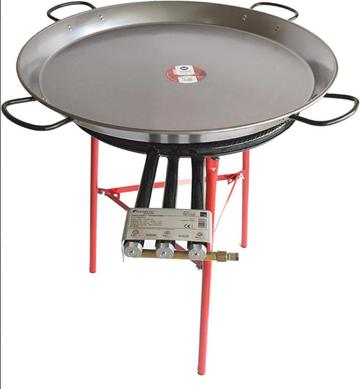

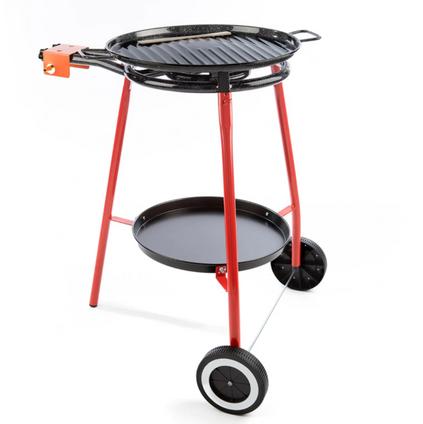
Spanish Paella Kit with Gas Burner & Polished Steel Pan24 inch (60 cm) up to 20 servings
Spanish Paella Kit with Gas Burner & Polished Steel Pan32 inch (80 cm) up to 40 servings

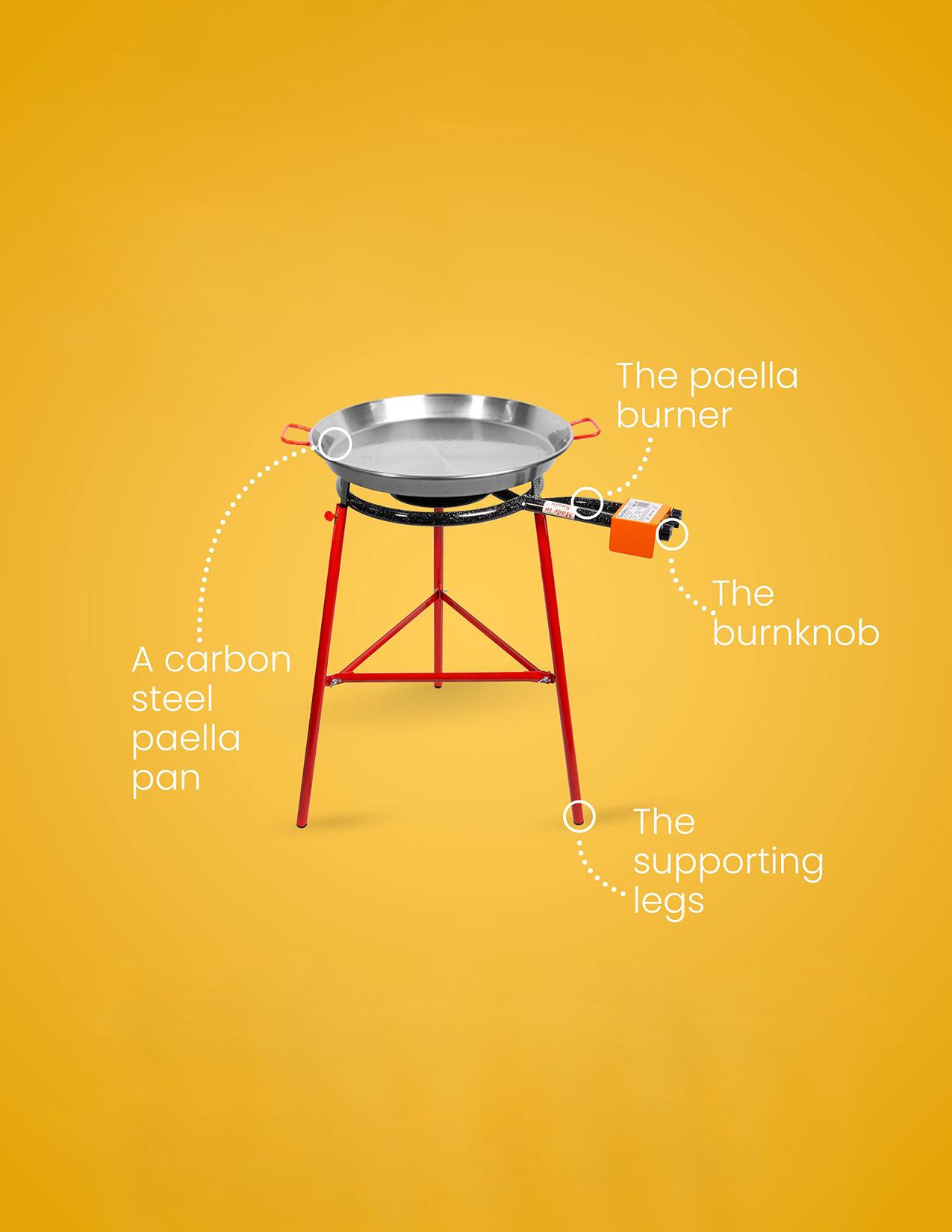





Crafting the perfect paella is an art, and using the right ingredients is essential to bring out the authentic flavors and textures that make this Spanish dish truly stand out In this chapter, we'll guide you through the process of selecting the finest ingredients for your paella, ensuring that your culinary creation is a celebration of the rich Spanish heritage
When it comes to paella, rice is the star of the show. The ideal rice for paella should be short-grain and have a high starch content, which allows it to absorb the flavors of the broth and other ingredients. Some of the best rice varieties for paella include:
Bomba: Known for its excellent absorption capacity, Bomba rice maintains its firm texture even when cooked, preventing it from turning mushy.
J-Sendra: This variety is prized for its flavor retention and its ability to remain separate and firm when cooked.
Calasparra: Grown in the Spanish region of Murcia, Calasparra rice is known for its longer cooking time and slightly nutty flavor.



A flavorsome broth is crucial for imparting depth and richness to your paella. While homemade broth is always an excellent choice, you can also opt for high-quality store-bought options like El Paeller, which offers a range of broths that can be tailored to the type of paella you're preparing, be it seafood, meat, or vegetable-based.
The base of any paella starts with olive oil, which lends its characteristic flavor to the dish. Opt for a premium extra virgin olive oil like Maria el Alteţ, which is produced in Spain and boasts a fruity, well-rounded flavor that complements paella's other ingredients



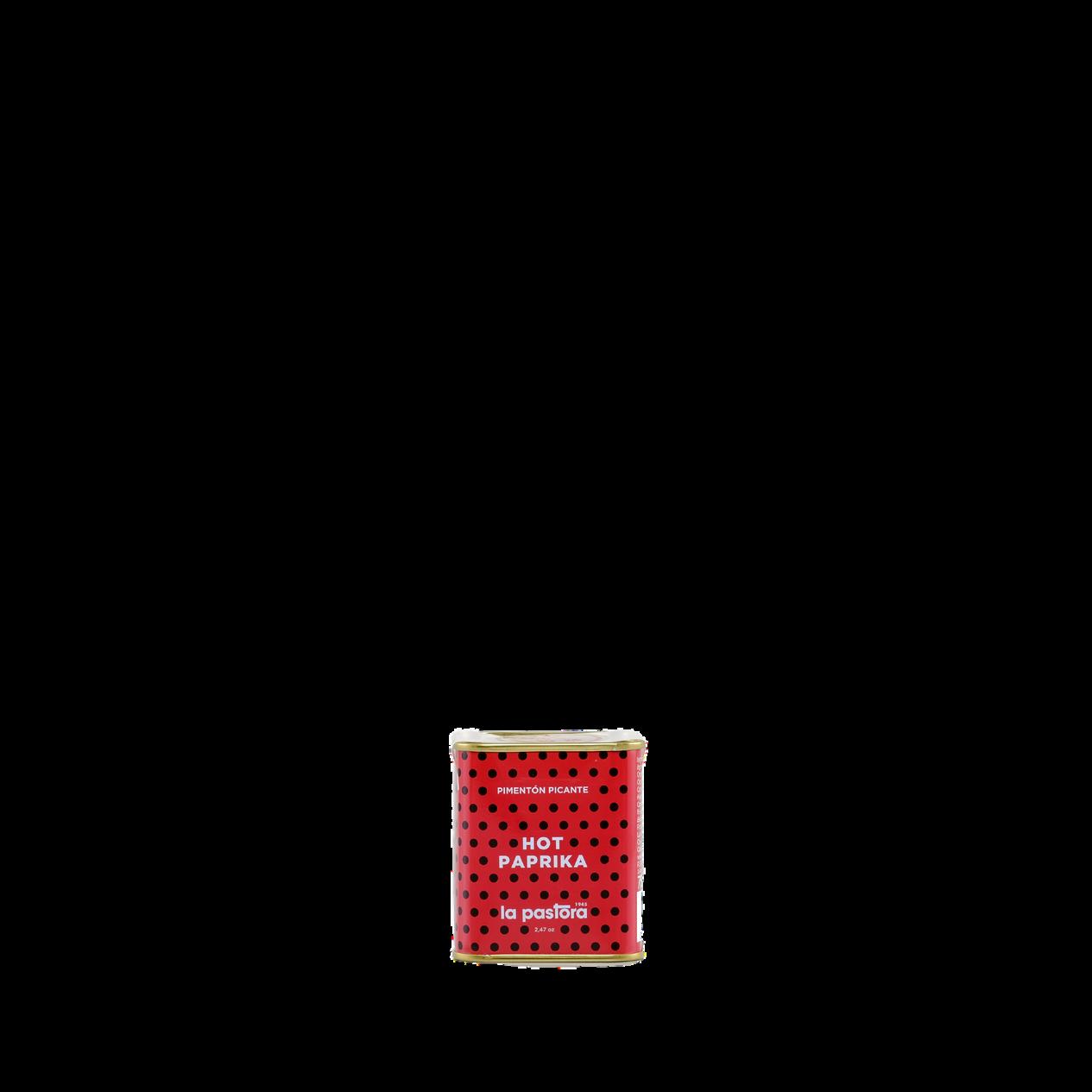
Paella's signature flavors come from a delicate balance of spices. Key among them is saffron, which imparts the dish's distinctive golden hue and subtle earthy aroma Paprika, both sweet and smoked, adds depth and warmth, while a good-quality salt enhances the flavors of all the other ingredients.
 Joel Robuchon Extra Virgin Olive Oil - 16 9 fl oz
Premium Extra Virgin Olive Oil - 16 9 fl oz
High End Extra Virgin Olive Oil - 16 9 fl oz
Sweet Paprika from Spain2 47 oz
Hot Paprika from Spain2 47 oz
Joel Robuchon Extra Virgin Olive Oil - 16 9 fl oz
Premium Extra Virgin Olive Oil - 16 9 fl oz
High End Extra Virgin Olive Oil - 16 9 fl oz
Sweet Paprika from Spain2 47 oz
Hot Paprika from Spain2 47 oz

The choice of protein and vegetables in your paella will be dictated by the specific recipe and regional variation you're following. Traditional options include chicken, rabbit, and snails for meat-based paellas, while seafood paellas feature a mix of fish, prawns, mussels, and clams Fresh, seasonal vegetables like bell peppers, tomatoes, peas, and artichokes are also commonly used. Choose the freshest, highest quality ingredients you can find, as they will make all the difference in the final dish
Choosing the right ingredients is the first step in mastering the art of paella By carefully selecting the best rice, broth, olive oil, spices, protein, and vegetables, you'll be well on your way to creating a dish that is not only delicious but also a true reflection of the rich culinary traditions of Spain






Mastering the art of paella requires more than just the finest ingredients; it also demands a firm grasp of the basic techniques that ensure a beautifully cooked and flavorful dish. In this section of our eBook, we'll introduce you to the fundamental steps and tips for achieving an excellent paella From the initial sofrito and layering of flavors, to the even cooking of rice and the formation of the coveted socarrat, we'll guide you through the essential techniques that will elevate your paella to new culinary heights So, let's embark on this flavorful journey together and learn the secrets behind creating an outstanding paella that will impress your family and friends!

7 ⅓ cups water
½ pound small clams, purged of sand Salt
½ pound mussels, scrubbed and debearded 6 tablespoons extra-virgin olive oil
1 green bell pepper, cored, seedles, and cut into 1-inch-square pieces
1 pound cuttlefish or squid, cut into 2-by ½inch pieces
12 to 18 large raw head-on shrimp with shells
6 raw head-on prawns or colossal shrimp with shells
4 ripe medium tomatoes, peeled, seeded, and finely chopped or coarsely grated
½ teaspoon sweet pimentón
2 pinches saffron threads (about 20 total), lightly toasted and grounded
¼ cup fresh or thawed frozen peas
2½ cups short- or medium-grain rice
In a medium saucepan, bring 5 cups of the water to a boil and add the clams and a pinch of salt Reduce the heat and simmer, partly covered, for 30 minutes Remove from the heat and set aside, covered, leaving the clams in the water
SERVES 6 |
Meanwhile, put the mussels in a small sauté pan, add ⅓ cup of the water, and bring to a boil. Reduce the heat and simmer, uncovered, until all of the mussels have opened, 3 to 5 minutes Remove from the heat, and set aside, covered Do not drain
Prepare the sofrito. In a 16- to 18-inch paella pan, heat the oil over medium heat Add the bell pepper and cook, stirring frequently, until it begins to brown and become fragrant, about 3 minutes Add the cuttlefish and cook until browned and its moisture has been expelled, about another 5 minutes, stirring constantly and scraping anything that sticks to the pan Add the shrimp and cook until pink, about 2 minutes on each side. Lower the hert to medium-low and add the prawns, tomatoes, and 2 pinches of salt and cook, stirring froze time to time, until the tomato has darkened to a deeper shade of red and the sofrito is pasty, 10 to 15 minutes.
Meanwhile, strain the broth from the clams, and reserve it Discard one shell (the empty one) from each clam and set aside the rest.
When the sofrito is ready, sprinkle in the pimentón and saffron, letting the flavors meld for a few seconds while stirring constantly.
Stir 4 cups of the reserved clam broth plus the remaining 2 cups of water into the paella, and add the clams and peas. Simmer for 10 min-utes. Taste for salt and adjust the seasoning as needed Remove the prawns and transfer to a platter Increase the heat, return the mix ture to a boil, and sprinkle in the rice. With a wooden spoon, probe the pan to make sure the rice is evenly distributed Do not stir again
Cook, uncovered, for 10 minutes over high heat. Reduce the heat to low and cook for an additional 8 minutes, or until the liquid is absorbed and the rice is al punto, with just a bite to it. Remove from the heat, cover with paper towels, and let rest for 5 minutes.



SERVES 6 | Paella valenciana does not have a precise recipe- it was born in the fields and not in a chef's restaurant kitchen- but there is an accepted ingredients list This recipe is adapted from the official one used in Sueca's nearly fifty-year-old annual paella competition, held in the Albufera village of Sueca each year, and approved by town government as well as the Club of Head Chefs of the Community of Valencia.
The only additions here are some herbs to make the snails tastier
Paella valenciana famously uses different types of fresh beans, namely garrofo (ima beans), tavella (a type of long white bean), and ferraúra (a local green bean).
Fresh lima beans are shucked from the pod, but the white beans and green beans are not; their pods are cut into short sections. Lima bears san be hard to find fresh, and canned or frozen are acceptable. Dried lima beans sent ho be soaked and boiled before adding to the paella
Fresh white beans can also be difficult to find (Look in Italian and French markets); again, dried ones need to be soaked and boiled before adding
You can also do what Spanish cooks do: use the fresh beans that look best in the market.
1 pound chicken thighs or legs, cut into 8 to 10 pieces ½ rabbit (about 1 pound), cut into 6 to 8 pieces
Salt
6 tablespoons extra-virgin olive oil
½ pound shucked fresh lima beans
¼ pound fresh small white beans in their pods, ends trimmed, and cut into 2-inch-long sections
½ pound green beans, ends trimmed, and cut in half 2 garlic cloves, finely chopped
2 ripe medium tomatoes, peeled, seeded, and finely chopped or coarsely grated
36 live or preserved snails, cooked, or 1 sprig fresh
rosemary
1 teaspoon sweet pimentón
8 cups water
2 pinches saffron threads (about 20 total), lightly toasted and ground
3 cups short- or medium-grain rice
Season the chicken and rabbit generously with salt. In a 16- to 18-inch paella pan, heat the oil over medium heat. Add the chicken and rabbit and cook, stirring frequently, until browned, about 5 minutes Add all the beans and cook until they begin to soften, about 5 minutes. Reduce the heat to medium-low, add the garlic, tomatoes, and 2 pinches of salt and cook, stirring from time to time, until the tomato has darkened to a deeper shade of red, 10 to 15 minutes. Stir in the snails (if using), sprinkle in the pimentón, and add the water Bring to a simmer, and continue simmering for 10 minutes, or until the meat and beans are tender.
Add the saffron and (if you are not using snails) the rosemary Taste for salt and adjust the seasoning as needed. Increase the heat to high and bring to a boil. Sprinkle in the rice. With a wooden spoon, probe the pan to make sure the rice is evenly distributed
Do not stir again Cook, uncovered, for 10 minutes over high heat, then reduce it to low and cook for an additional 8 minutes, or until the liquid is absorbed and the rice is al punto, with just a bite to it. Remove the paella from the heat, cover with paper towels, and let rest for 5 minutes before serving.

NOTE: If using live snails, clean the shells well and put in a medium saucepan. Add 1 quartered tomato, 1 quartered onion, 1 teaspoon sweet or bittersweet pimentón, 1 sprig fresh rosemary, and 1 small handful fresh mint. Cover with abundant cold water and slowly bring to a boil. Reduce the heat to low and simmer for 1 hour. Drain the snails, rinse, and set aside If using preserved snails, rinse, put in a medium saucepan, cover with abundant water, and boil for 3 to 4 minutes. Drain, rinse, and set aside.


SERVES 4 | Vegetable paella is one of the classic paellas. Use whatever vegetables are in season-asparagus in spring, mushrooms in autumn, turnips in winter-and look freshest in the market

Vegetable paellas are just as adaptable to seasons, tastes, and whims as those with meat and seafood.
6 tablespoons extra-virgin olive oil
1 red bell pepper, cored, seeded, and cut into 1-inch-square pieces
1 medium eggplant, peeled and cut into ½-inch-dice
¼ pound green beans, ends trimmed and cut into 1-inch pieces
3 medium artichokes, trimmed, tough parts of leaves removed, cut into
eighths, and choke scraped out only the last inch used
½ pound cauliflower, broken into bite-size pieces
9 tender garlic shoots, root ends trimmed, outer layers peeled away, and
2 garlic cloves, finely chopped
4 ripe medium tomatoes, peeled, seeded, and finely chopped or coarsely
grated
Salt
6 cups Vegetable Stock or water
½ teaspoon sweet pimenton
2 pinches saffron threads (about 20 total), lightly toasted and ground
⅓ cup fresh or thawed frozen peas
2 cups short- or medium-grain rice
heat. Add the bell pepper and eggplant and cook until they begin to brown, about 5 minutes Transfer to a plate Add the remaining 2 tablespoons of oil to the pan, and then add the green beans, artichokes, and cauliflower and cook for 5 minutes Lower the heat to medium-low, add both types of garlic, the tomatoes, and 2 pinches of salt: and cook, stirring from time to time, until the tomato has darkened to a deeper shade of red and the sofrito is pasty, 10 to 15 minutes
Add 1 cup of the stock and simmer until the liquid has evaporated and the vegetables are tender, about 10 minutes Return the bell pepper and eggplant to the pan. Sprinkle in the pimentón and saffron, letting the flavors meld for a few seconds while stirring constantly. Add the remaining 5 cups of stock and the peas, increase the heat, and bring to a boil Taste for salt and adjust the seasoning as needed. Sprinkle in the rice.
With a wooden spoon, probe the pan to make sure the rice is evenly distributed. Do not stir again. Cook, uncovered, for 10 minutes over high heat, then reduce the heat to low and cook for an additional 8 minutes, or until the liquid is absorbed and the rice is al punto, with just a bite to it Remove the paella from the heat, cover with paper towels, and let it rest for 5 minutes before serving.

SERVES 6 | This classic Catalan coastal rice dish is not only colored by the black cuttlefish or squid ink, but also flavored by its tight, briny essence

The ink sac, of course, comes inside the squid, so when cleaning be sure to reserve it, or ask your fishmonger to do so. Ink can also be purchased in some specialty shops; 2 teaspoons is plenty The flavor of the rice is mellow, almost sweet, and is perfect served with creamy garlic Allioli.
5 tablespoons extra-virgin olive oll
1 medium onion, finely chopped
1 red bell pepper, cored, seeded, and cut into 1-inch-square pieces
2 pounds cuttlefish or squid, cleaned and cut into bite-size pieces, ink sac(s) reserved; or 1 pound cut-up cuttlefish or squid
steaks and 2 teaspoons Ink
4 ripe medium tomatoes, peeled, seeded, and chopped or coarsely grated Salt
2 garlic cloves, peeled
7 cups Fish Stock
1 teaspoon sweet pimentón
In a 16- to 18-inch paella pan, heat the oil over medium-low heat Add the onion and bell pepper and cook until the onion is soft and translucent, 5 to 10 minutes. Add the cuttlefish and cook for 5 minutes, stirring and scraping

anything that sticks to the pan. Add the tomatoes and 2 pinches of salt and cook, stirring from time to time, until the tomato has darkened to a deeper shade of red and the sofrito is pasty, 10 to 15 minutes
Meanwhile, pound the garlic in a mortar. Add the ink sac(s) and a dash of fish stock and carefully mash with the garlic into a runny paste
When the sofrito is ready, sprinkle in the pimentón and saffron, letting the flavors meld for a few seconds while stirring constantly.
Add the stock, increase the heat, and bring to a boil. Add the rice and spoon in the garlic-ink paste. Check for salt, adjusting the seasoning as needed
With a wooden spoon, probe the pan to make sure the rice is evenly distributed. Do not stir again. Cook, uncovered, for 10 minutes over high heat, then reduce the heat to low and cook for an additional 8 minutes, or until the liquid is absorbed and the rice is al punto, with just a bite to it.
Remove the paella from the heat, cover with paper towels, and let rest for 5 minutes before serving. Serve with allioli on the side in a bowl, encouraging people to dollop the sauce liberally on the rice
g seafood
180 ml Masia El Altet extra virgin olive oil
12 oz fideua “Romero” noodles or any angel hair pasta broken into 1 in lengths
1 fresh squid (about 350 gr or 0.8 lbs.), cleaned and chopped into 1 in pieces
8 prawns, one or two per person (defrosted if frozen)
1 fresh peeled shrimps (250 gr or 0.5 lbs.)
10 oz precooked mussels in the shell
2 garlic cloves, finely chopped
¼ Spanish onion, finely chopped
2 tomatoes (shredded)
Pinch of saffron “Carmencita.”
½ tsp sweet “Carmencita” pimentón (smoked or hot Spanish paprika)
½ tsp seafood “Carmencita” dry paella stock

½ tsp chopped nora “Carmencita” pepper (ñora)
1 tsp salt
Abundant fish stock El Navarrico, we will use two measures for each measure of noodles
Heat about one-third of the olive oil in a wide frying pan over a medium heat. Add the dried pasta and fry for about 5 minutes, or until it turns golden. Remove from the pan and set aside.
Add the rest of the olive oil to the pan, increase the heat and add the chopped squid and salt
We recommend that you keep a safe distance from the paella pan and use a wood-handle paella spoon, so the steam can escape safely. Stir quickly and let cook for a few more minutes. Don’t scrape the bottom of the pan, as that sticky layer on the bottom is essential for making a rich stock.

When the squid has browned, add the peeled prawns, garlic and onion, and cook for another 5 minutes until everything is dark golden (this will happen fairly quickly because of the high heat). Add the shredded tomatoes, saffron, nora and paprika and stir constantly to dissolve the sticky bits on the bottom. This should take no longer than 2 minutes.
Add El Navarrico fish stock Bring to the boil and let it simmer for about 10 minutes before adding the previously golden pasta and the mussels. You need to use your judgement here – you need just enough stock left in the pan for the pasta to cook and absorb all the remaining liquid. Stir in the pasta and cook until the liquid has been absorbed.
Remove from the heat and leave for 1 more minute to create a toasted layer of pasta on the bottom of the pan – it will taste like
While paella is undoubtedly the star dish when it comes to using your paella pan, this versatile piece of cookware can also be employed to create a variety of other delicious meals.

The wide, flat surface and even heat distribution of a paella pan make it perfect for grilling steaks, chicken chops, or fish fillets, allowing you to achieve a delightful sear on the outside while keeping the inside tender and juicy






A meal as delectable and festive as paella deserves to be complemented by equally delightful side dishes and wine pairings. In this chapter, we'll explore a selection of accompaniments that elevate the paella experience, as well as recommend wine pairings that harmonize with the dish's rich flavors and textures.
While paella is a complete meal in itself, there are a few traditional side dishes that can enhance your dining experience:

Green Salad: A simple, fresh green salad with a light vinaigrette is a refreshing contrast to the richness of paella Choose a mix of tender greens, such as baby spinach, arugula, or mâche, and toss with thinly sliced red onion, cherry tomatoes, and olives for a touch of Mediterranean flair
Pan con Tomate (Spanish Tomato Bread): This iconic Spanish tapa pairs beautifully with paella. Made with rustic bread rubbed with ripe tomatoes and drizzled with olive oil, pan con tomate offers a delicious combination of flavors and textures.
Alioli (Garlic Mayonnaise): A dollop of creamy alioli on the side adds a touch of indulgence to your paella The bold garlic flavor complements the dish's savory notes, while the creamy texture adds richness.
The perfect wine pairing for paella depends on the specific ingredients and flavors of the dish. Here are some suggestions to guide your choice:

For seafood paella: Opt for a crisp, refreshing white wine that complements the delicate flavors of fish and shellfish Albariño, Verdejo, or a Sauvignon Blanc from Spain would be excellent choices. For meat-based paella: A medium-bodied red wine with moderate tannins and acidity, such as a Spanish Tempranillo or Garnacha, will balance the rich flavors of the meats without overpowering the dish. For vegetable paella: A versatile white or rosé wine will enhance the flavors of the vegetables and herbs. Consider a Spanish Viura, a French Grenache rosé, or even a Cava for a touch of effervescence.
If you're not a Wine person, Gin Tonic is an excellent substitute to pair with this delicious plate.
The right accompaniments and wine pairings can elevate your paella experience to new heights. By selecting fresh, flavorful side dishes and wines that harmonize with your paella's ingredients, you'll create a memorable dining experience that celebrates the vibrant spirit of Spanish cuisine





Your paella pan is the foundation of your culinary adventures in the world of Spanish cuisine Proper care and maintenance will ensure that your pan remains in excellent condition for years to come, allowing you to continue creating delectable paellas and other dishes. In this chapter, we'll guide you through the best practices for cleaning and storing your paella pan to keep it in tip-top shape.
After cooking, allow your paella pan to cool down before cleaning Never immerse a hot pan in cold water, as this may cause it to warp. For enameled or stainless steel paella pans, wash with warm, soapy water and a soft sponge to remove any food residue. Avoid using abrasive scouring pads, as these can damage the pan's surface.
For traditional carbon steel pans, clean with a mix of warm water and a small amount of mild detergent. Gently scrub with a non-abrasive sponge or cloth to remove food particles. To remove any remaining traces of detergent, rinse the pan thoroughly with warm water
If your pan has developed any stubborn, stuck-on food, fill it with warm water and let it soak for a short while before gently scrubbing it clean.
After cleaning, dry your pan thoroughly using a clean, soft cloth or paper towel to prevent rusting. For carbon steel pans, place the pan on low heat for a few minutes to ensure that it is completely dry.
Carbon steel pans require regular seasoning to maintain their nonstick properties and prevent rusting. To season your pan, apply a thin layer of vegetable oil to the interior surface, then heat the pan on low heat for a few minutes Allow it to cool, then wipe off any excess oil with a paper towel.
Store your paella pan in a cool, dry place to prevent rust and moisture damage If possible, hang the pan from a hook to allow air circulation and avoid any potential scratches from stacking.
If you must stack your pan with other cookware, place a sheet of parchment paper, a clean cloth, or a silicone mat between the pans to protect their surfaces.
Proper care for your paella pan is essential to ensure its longevity and optimal performance By following these cleaning, seasoning, and storage guidelines, you'll be able to enjoy delicious paella creations and other dishes for years to come.

help themselves. Be sure to provide each guest with a wooden or non metallic spoon, as these materials won't damage your paella pan's surface.


